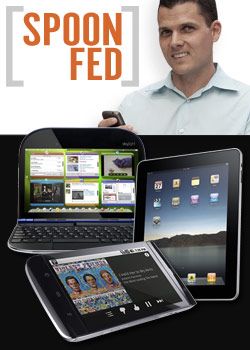Attack of the Tweeners: Handicapping MIDs, Tablets, and Smartbooks

For every company that’s excited about creating a device that falls between smart phones and netbooks, there are five others that tell me that they’re still trying to figure out what problem these tweeners are trying to solve.
From smallest to biggest you have mobile Internet devices (MIDs), tablets (not to be confused with Tablet PCs), and smartbooks.
But what are these things really?
What makes defining these relatively new gadget categories complicated is that there is some overlap between them. For example, just yesterday ABI Research said that four million “media tablets” shipped this year, and that by 2015 that number will reach about 57 million.
Basically combining MIDs and tablets, the firm defines these devices “as having a touchscreen interface, 5 to 11 inches in size, with Wi-Fi Internet connectivity and video and gaming capabilities.” Meanwhile, Google says it’s upcoming OS will power the next generation of netbooks, when the reality is that they’re referring to smartbooks.
Here’s a breakdown of how I define these categories and my predictions for their chance of success. Don't agree with these definitions? Think my predictions are off? Sound off in the comments.
| Device | Mobile Internet Devices (MIDs) | Tablets (Media Tablets) | Smartbooks |
| Screen Size | 5 - 7 inches | 9 - 10 inches | 9 - 10 inches |
| Price Range | $200 to $600 | $300 to $600 | $200 to $500 (estimated) |
| What are they? | Slightly larger than smart phones, MIDs are designed to deliver a full Web experience in your pocket. | Slate-style devices that are optimized for surfing the Web, reading eBooks, and accessing multimedia. | Clamshell devices that offer instant-on functionality, integrated 3G connectivity, and long battery life. |
| Who are they for? | Shoppers who want a bigger screen than a smart phone for surfing the Web and accessing multimedia. | Couch potatoes, business travelers, avid readers, and anyone looking for a low-cost Internet appliance. | Shoppers who like the idea of owning a smart phone but would prefer a bigger screen and keyboard. |
| Processor Choices | ARM and Atom CPUs | ARM and Atom CPUs | ARM CPUs (Snapdragon, Tegra) |
| OS Choices | Most run Linux (Android), some Windows | Android, iPhone OS, Windows 7 | Android and other flavors of Linux. Google Chrome coming soon. |
| Best Known Products | Archos 5, Dell Mini 5 concept, ICD Ultra, UMID M1, Viliv N5 | Apple iPad, HP Slate, JooJoo, MSI Dual-Screen Tablet, Notion Ink Adam | Lenovo Skylight, Mobinova Beam |
| Pros | More compact than tablets (can fit in coat pocket). Bigger screens make Flash content (when supported) more compelling. Some can run full Windows and have (cramped) physical keyboards, like a mini netbook | Less expensive than traditional Tablet PCs. Touch interface and large screen combine to offer compelling Web surfing experience. Many double as eReaders and can run touch-enabled apps and games. | Thinner, lighter, and boots faster than Windows netbooks Built-in mobile broadband and GPS come standard. Will likely be affordable (with carrier subsidy). Lasts 8 to 10 hours on a charge without bulky battery. |
| Cons | Smart phones are getting bigger screens and faster processors, making MIDs seem somewhat redundant. Android-based MIDs have shortage of apps that run at full screen. Windows-based MIDs not as touch friendly. | Tablets based on phone OSes not as versatile as full PCs, and multitasking is either clumsy or non-existent. Models based on desktop OSes lack breadth of touch-enabled apps and likely won't last as long on a charge. | Consumers have not embraced Linux on netbooks, and there is zero evidence this will change for smartbooks. Windows is more familiar, has better peripheral support, and runs more popular applications. |
| Real Chance of Success | 20 % Because the next generation of "superphones" have 1.0-GHz processors and 4-inch (or larger) displays, it's hard to see this category having any staying power. But consumers looking for a connected portable media player or gaming device could be tempted. MIDs are becoming smart phones. | 70 % Even though the Apple iPad has some limitations, it is creating a great amount of buzz and excitement for the entire category. Tablets will likely replace eReaders as screen technologies evolve. In some cases, tablets will also cannibalize sales of netbooks, especially among those looking for a simple Internet appliance. | 40 % Given that you can get a Windows 7 netbook for $200 or less on contract, it's hard to see smartbooks taking off in the short term. But they could gain some momentum once Web apps get more robust (with the help of HTML 5). In the meantime, carriers will need to figure out how to play up smartbooks’ unique strengths. |
$200 to $600
Stay in the know with Laptop Mag
Get our in-depth reviews, helpful tips, great deals, and the biggest news stories delivered to your inbox.
